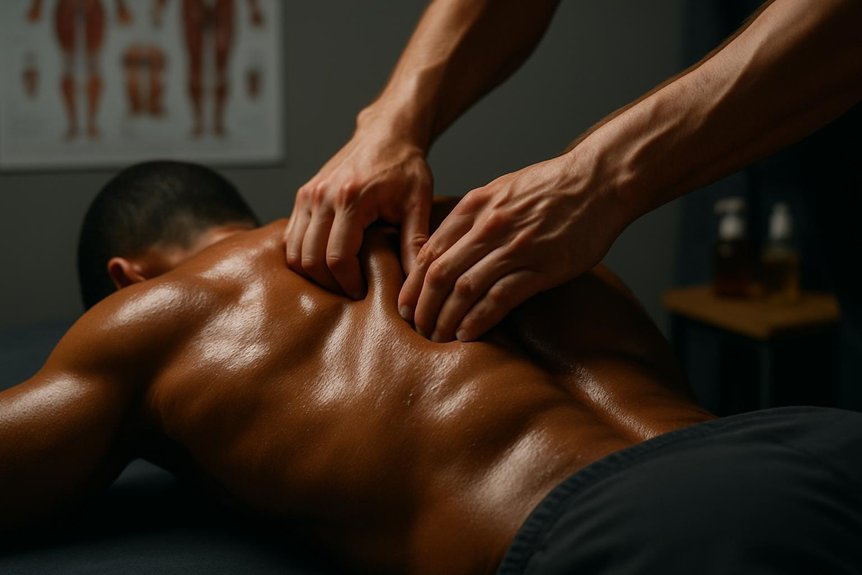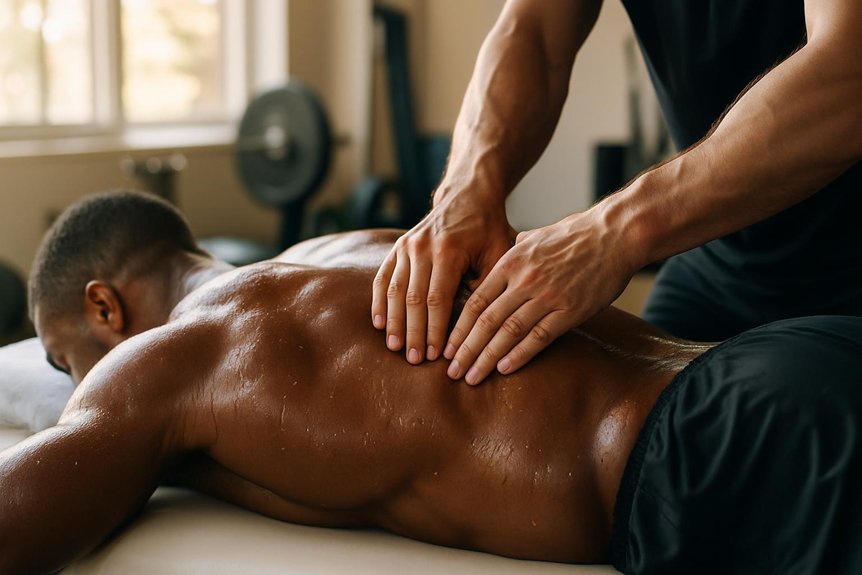This massage does not directly increase muscle mass, as muscle growth fundamentally relies on mechanical tension and resistance training. However, it plays a significant role in supporting muscle recovery by improving circulation, reducing fascial adhesions, and promoting tissue repair. This helps alleviate tension, minimize soreness, and create favorable conditions for continued training and hypertrophy. For those interested in optimizing muscle health and supporting sustained physical development, further exploration offers substantial guidance and practical strategies.
Understanding Deep Tissue Massage

How does this massage differ from other modalities in its therapeutic approach? Deep muscle therapy employs targeted, sustained pressure and slow strokes to reach deeper layers of fascia and musculature.
Unlike relaxation-focused techniques, this modality is designed to address chronic tension, adhesions, and restricted movement patterns. At Spa & Massage, therapists conduct thorough assessments to individualise each session, ensuring that pressure is both therapeutic and attuned to client comfort.
Evidence suggests deep muscle therapy enhances circulation, reduces inflammation, and supports myofascial release, facilitating a profound sense of relief and connection. Clients often report a heightened awareness of their bodies post-treatment, indicating the intimate, restorative effect of this approach.
Spa & Massage prioritises precision and professional care, fostering trust and meaningful outcomes for every individual. In addition to these benefits, deep tissue massage can support the process of myofascial release by breaking up adhesions and improving muscle flexibility over time.
How Muscles Grow: The Basics of Muscle Building
Muscle hypertrophy is primarily driven by mechanical tension, metabolic stress, and muscle fiber microtrauma induced through resistance exercise.
The application of progressive overload serves as a critical stimulus, prompting muscle adaptation and growth.
Adequate recovery periods are essential, as this is when the physiological repair and strengthening of muscle tissue occur.
Muscle Growth Mechanisms Explained
Two primary physiological processes drive skeletal muscle growth: hypertrophy and, to a lesser extent, hyperplasia. Hypertrophy refers to the enlargement of existing muscle fibers through increased protein synthesis, typically in response to mechanical tension or microtrauma.
Hyperplasia, while less common, involves an increase in the number of muscle fibers. Both mechanisms are mediated by cellular signaling pathways, hormonal responses, and satellite cell activation.
The adaptive process is influenced by an individual’s genetic predisposition, nutritional status, and recovery strategies.
At Spa & Massage, therapists understand these mechanisms and design supportive interventions to facilitate ideal muscle adaptation. By focusing on promoting circulation, reducing inflammation, and supporting tissue health, clients can create an environment conducive to muscle growth, enhancing both physical wellbeing and connection with their own bodies.
Role of Exercise Stimulus
When subjected to sufficient mechanical load and progressive resistance, skeletal muscle fibers experience microtrauma, which initiates the remodeling process essential for muscle growth. This physiological response is primarily triggered by structured exercise, such as resistance training, where repeated contractions under load stimulate muscle protein synthesis.
The resulting micro-injuries activate satellite cells and anabolic signaling pathways, supporting hypertrophy as fibers adapt to increased demands. Within Spa & Massage clinics, clients are routinely educated on the necessity of consistent exercise stimulus for sustainable muscle development.
Therapists emphasize that while deep muscle therapy enhances circulation and assists with mobility, it does not replace the foundational role of physical training in building lean muscle mass. Understanding this distinction helps clients align their wellness routines with evidence-based muscle growth strategies.
Importance of Recovery Time
Following structured resistance training, the physiological processes that drive muscle hypertrophy are most effective during periods of rest. During recovery, muscle fibres undergo repair and protein synthesis, facilitating adaptation and growth.
Inadequate rest periods disrupt these anabolic mechanisms, increasing risk of overtraining and impeding gains. Clinical evidence underscores the necessity of sleep, nutrition, and stress reduction as foundational elements supporting muscular adaptation.
At Spa & Massage, therapists emphasise the significance of holistic recovery within muscle-building protocols. Deep muscle therapy, delivered by trained professionals, may enhance local circulation, reduce delayed onset muscle soreness (DOMS), and promote parasympathetic nervous system activity.
This integrative approach supports the body’s innate healing processes. Clients are encouraged to view recovery as an essential investment in their overall strength, wellbeing, and long-term training success.
The Role of This Massage in Muscle Recovery

How does this type of massage contribute to the process of muscle recovery?
Deep muscle therapy targets the deeper layers of muscle fibers and connective tissue, facilitating improved circulation and lymphatic flow.
At Spa & Massage, therapists employ precise manual techniques to address myofascial adhesions, reduce localized inflammation, and promote metabolic waste removal.
This process assists in alleviating delayed onset muscle soreness (DOMS) and accelerates the natural repair mechanisms of the musculoskeletal system.
Clients often report a reduction in muscle tension and a restored sense of physical ease following sessions.
The focused pressure and tailored approach used by Spa & Massage therapists support both acute and chronic recovery needs, fostering an environment where muscles can heal more efficiently and clients feel a renewed connection to their bodies.
Can This Massage Stimulate Muscle Growth?
While deep muscle therapy does not directly increase muscle mass in the way that resistance training does, it plays a significant supportive role in the muscle-building process.
Clinical evidence suggests that this massage enhances circulation, reduces fascial restrictions, and improves muscle pliability.
At Spa & Massage, therapists employ targeted techniques to address adhesions and tension, supporting ideal muscle recovery and function.
By facilitating nutrient delivery and waste removal at the cellular level, massage optimises the environment for hypertrophy and repair after exercise.
This approach may indirectly promote muscle growth by enabling clients to train consistently, reduce risk of injury, and experience less post-exercise soreness.
For individuals focused on muscle development, integrating massage into their routine provides a holistic, client-centred strategy for maximising results.
Benefits of Deep Tissue Massage for Active Lifestyles
Beyond supporting muscle development, deep muscle therapy offers a wide spectrum of benefits for those leading active lifestyles. Clinical evidence demonstrates that targeted manual therapy can alleviate delayed onset muscle soreness by modulating inflammatory responses and promoting enhanced microcirculation.
Clients at Spa & Massage frequently report reductions in muscle tension, accelerated recovery after intense activity, and improved joint mobility. Deep tissue techniques address fascial adhesions and chronic myofascial tightness, which are prevalent among individuals engaged in regular exercise or demanding physical routines.
Therapists at Spa & Massage employ precise, client-focused protocols to foster musculoskeletal balance, reduce the risk of overuse injuries, and optimise functional movement patterns. Regular sessions are tailored to individual needs, encouraging deeper connection with one’s body, while facilitating relaxation and restoring energetic equilibrium—key for sustained performance and overall well-being.
Recommended Massage Practices for Muscle Support
A structured approach to massage therapy is essential for supporting muscle health and enhancing recovery. At Spa & Massage, therapists recommend consistent, individualized sessions that address specific muscular concerns, such as tension, adhesions, and post-exertional discomfort.
Techniques like deep tissue manipulation, myofascial release, and targeted trigger point therapy are employed to optimize circulation, alleviate restrictions, and promote efficient tissue repair.
Clients are encouraged to communicate their physical needs and preferences, allowing therapists to tailor pressure and focus areas with precision. The use of high-quality massage oils, selected for their skin compatibility and therapeutic properties, further enhances the effectiveness and comfort of each session.
Adhering to a regular schedule enables cumulative benefits, supporting muscle resilience and fostering a sense of holistic well-being.
Enhancing Your Fitness Routine With Professional Massage
In the context of a structured fitness regimen, integrating professional massage can markedly enhance musculoskeletal adaptation and recovery outcomes. Clinical evidence indicates that deep tissue and sports massage, as employed by Spa & Massage therapists, facilitate increased local circulation, reduction of delayed onset muscle soreness, and improved joint mobility.
These benefits collectively support an individual’s capacity for consistent training, accelerating post-exercise recovery and minimizing risk of soft tissue injuries.
Many clients at Spa & Massage report heightened body awareness and a deeper connection to their physical wellbeing after regular massage sessions. Our therapists tailor modalities to each client’s physiological needs, using targeted pressure and therapeutic oils to optimize tissue pliability.
This client-focused approach guarantees that every session contributes meaningfully to both performance progression and holistic wellness.
Conclusion
In the intricate tapestry of muscular development, therapeutic deep massage serves as the skilled artisan—refining, supporting, but not directly weaving new muscle fibers. While current evidence underscores its role in ameliorating recovery, enhancing circulation, and mitigating soreness, it does not supplant the fundamental necessity of resistance training for hypertrophy. For clients at Spa & Massage, integrating professional massage is a strategic complement, not a substitute, within a thorough regimen for ideal musculoskeletal health and performance.



